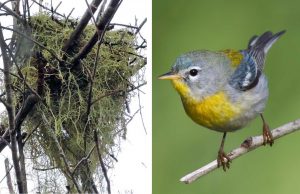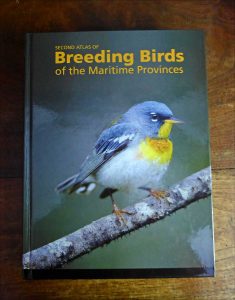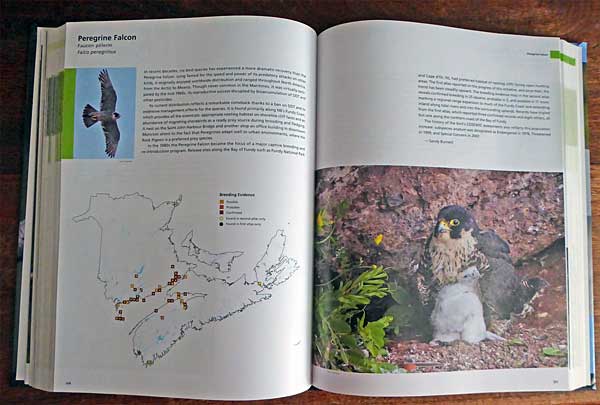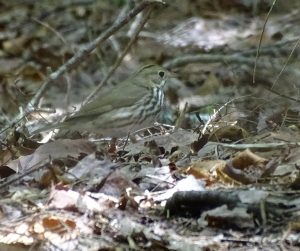
Northern Parula and Nova Scotia nest built from old-man’s-beard lichen. These are birds of mature forests. “Selective harvesting [not clearcutting] can be carried out, but should be outside the breeding season to cause the least impacts to bird populations” says Donna Crossland in Don’t let the music stop. Parula pic by Don Pancamo.
The posts are copied below.
We know a lot about when and where birds nest in Nova Scotia, thanks to the work of hundreds of birdwatchers towards the First (1992), and Second (2016) Atlas of Breeding Birds of the Maritimes Provinces, all available online:
Second Atlas of Breeding Birds of the Maritimes Provinces
“This Atlas is the single most comprehensive, up-to-date information source on the status of Maritimes breeding birds. More than 260,000 records of 222 species are included in the database, including more than 8,700 records of 17 species at risk. Produced as a beautifully-illustrated hard-cover book, the Atlas is complemented by a comprehensive website where maps, results and much else are accessible online.”
The Introductory chapters are highly informative, available in Part 1 and Part 2. Data and descriptive information for all species are given as links to PDFs under the Table of Contents.
It’s a beautiful book composition- and photograph-wise as well as content-wise; a print copy is a treasure.
Some excerpts from Ch 6: Applying the Atlas to Bird Conservation
Because of the incredible bird diversity that it supports, the Maritimes have an important responsibility for the stewardship of the global populations of many bird species. This responsibility is made all the more urgent by the region’s vulnerability to environmental perturbations and threats, such as atmospheric pollution, climate change, sea level rise, and the expansion and intensification of forestry and other uses of the land. Stewardship can take many forms—it includes any act that takes responsibility for the health of wildlife and their habitats through conservation activities and sustainable practices.
The Second Atlas of the Breeding Birds of the Maritime Provinces is a key tool for bird conservation, and its importance in policy and practice cannot be overstated. The atlas shows where birds are, how abundant they are, and, thanks to its replication of the first atlas, how their distribution and abundance have changed over time. This information is required to assess species status and to determine if and where conservation action is needed. It also serves as a continuing baseline for tracking population trends and measuring the success of conservation actions.
We just need to begin to apply what we know!
View also:
Anti-Clearcut Billboards go up in Halifax (Post, Mar 6, 2018)
Birds nests versus industrial forestry in Nova Scotia & what the Independent Review can do for us (Post, Jan 10, 2018)
Birds Page on this website
——————————-
From Birding News – Nova Scotia
Subject: Killing Endangered Species on Private Land is Ok
Date: Tue May 29 2018 16:10 pm
From: JK
Dear NatureNS readers,
I wish to express my sorrow about the state of environmental policy in the Province of Nova Scotia. I thought I couldn™t get more disheartened when the Premier indicated that oil and gas development should be permitted in Marine Protected Areas. While such a statement would be par for the course (no pun intended) for US President, Donald Trump. I didn™t expect it here.
Yesterday, however, this sorrow hit closer to home. In my home village of Carleton, in Yarmouth County, I witnessed what I believe to be the destruction of a Common Nighthawk nest by a forestry operation. I believe this because I was listening to a tree harvesting machine, blocked from my view from a stand of softwood, but very loud as I was only a couple hundred of meters away. All of a sudden, at about 2 PM, a Common Nighthawk flew up from where the machine was harvesting and subsequently circled the machine a couple of times before disappearing.
I immediately called the local office of the Department of Natural Resources. The regional biologist was not in but about an hour later a wildlife technician called to tell me not to worry. The biologist had indicated that Common Nighthawks don™t nest in the forest and have a wide foraging area so it was just passing by. I disputed this claim, noted that forestry should not be permitted during the bird breeding season, and asked that at minimum, the Department inform the landowner that an endangered species, listed under the Species at Risk Act, was likely nesting in the area of forestry operations. I was then informed there was nothing the government would do because the forestry operation was on private land.
So despite the fact that it is against the law (Migratory Birds Convention Act) to destroy the nest, eggs, or young of a migratory bird, and despite the fact the Common Nighthawk is protected by federal and Nova Scotia species at risk legislation, it is ok to destroy the nest, eggs, or young of an endangered migratory bird if it is on private property. I wonder if they are planning on allowing the hunting of fawns and moose calves on private property year-round too?
Thanks for listening to my lament.
——–
Subject: Killing Endangered Species on Private Land is Ok
Date: Tue May 29 2018 16:54 pm
From: BW
JK – and all,
You are not alone in your concern and are right to lament. Recently, I made some inquiries into protection of SAR bird species, and migratory birds in general — on Crown Land forests slated for harvest. What I discovered is that there isn’t much protection at all. There is very little being done to secure habitat for species. There is also very little being done to ascertain that SAR and other birds aren’t nesting on lands slated for harvesting — from what I could gather, no one is running bird atlas info or other data against planned harvest plots. There is also very little that can be done to protect birds that you suspect to be nesting in a harvest area unless you are practically able to prove beyond any shadow of a doubt that there is a nest there. If you can prove this to be true (photos of nest with bird and eggs I guess), you are supposed to be able to call some emergency number and something might possibly be done. As for protecting known breeding habitat, recommendations can be made to protect an area — there is a process — but apparently it is rarely done and, I gather, probably unlikely to be successful. So, the gist of all of this is that, really, these birds are not protected on Crown Land unless inside of some special conservation area. I was more than appalled by all of this after hearing back from all concerned. Frankly, I find it pretty shocking. It’s also quite infuriating that so many people have much to say about how forests and natural areas are managed in Mexico, Central and South America — we get angry that they aren’t doing a better job of protecting rain forests and other habitat from deforestation — yet, meanwhile, here we are in the north where these birds are actually nesting and raising young — and so little effort is being made to secure their breeding habitat. Very pathetic indeed.
——–
Subject: Killing Endangered Species on Private Land is Ok
Date: Tue May 29 2018 17:53 pm
From: DW
Hi JK & All, As I am sure all would agree, the crucial step in understanding and managing any complex system is identification of the coarse controls. If these, the large effects, are overlooked or out of adjustment then fiddling with the fine controls is just wishful thinking. The Common Nighthawk nests on bare ground and eats flying insects. It has been decades since I have heard a Nighthawk over Kentville. If anything, clearcut logging with lots of decaying brush to spawn insects should favor Nighthawks; nesting sites plus food. Do you honestly suppose that logging has caused this collapse of flying insects and Nighthawks ? Way above that tiny effect I would wager oversanitazion; doggy doo to the landfill (insane !; doggy doo is a resource for invertebrates and plants), yard trash bundled for indoor composting (insane; yard trash is the staff of life for many invertebrates), Bug zappers and the like (towns are death zones for flying insects; gee I wonder why bats got white mouth ?). Pogo, about 1956 hit the nail on the head while looking at a swamp half filled with assorted trash, “I have seen the enemy and he is us.” And unfortunately far too few people noticed; or noticed and forgot. Did your Nighthawk fly up from a nest or just fly into view from elsewhere ? Does it matter ? Birds are killed on public highways in great numbers. Should someone walk ahead of each vehicle with a lantern so this does not happen ? Another endangered species is the independent tree harvester. The profit margins are paper thin or negative and down time can land you in debt. Thus we have advanced to forestry by mowing machines 24/365.In my view the small independent logger, especially if selective cutting is practiced, should be subsidized (as in much of Europe) and not treated like some untouchable. End of rant.Yt, DW, Kentville
——-
Subject: Killing Endangered Species on Private Land is Ok
Date: Wed May 30 2018 6:45 am
From: JK
Dear DW,
I™m not against the small independent logger. But I do want them to refrain from logging in May through mid-July whether it is clearcutting or selective harvesting. And if they insist on cutting at that time, they should do a science-based survey for the endangered and sensitive species in the woodlot and avoid the areas they inhabit. Stewardship should never be sacrificed for profit margins. As radical as this sounds, the creatures of the forest should be regarded with the same dignity as you rightfully bestow on the small independent logger.
———-
Subject: Killing Endangered Species on Private Land is Ok
Sent: Tuesday, May 29, 2018 18:35
From BW
JK – and all,
You are not alone in your concern and are right to lament. Recently, I made some inquiries into protection of SAR bird species, and migratory birds in general — on Crown Land forests slated for harvest. What I discovered is that there isn’t much protection at all. There is very little being done to secure habitat for species. There is also very little being done to ascertain that SAR and other birds aren’t nesting on lands slated for harvesting — from what I could gather, no one is running bird atlas info or other data against planned harvest plots. There is also very little that can be done to protect birds that you suspect to be nesting in a harvest area unless you are practically able to prove beyond any shadow of a doubt that there is a nest there. If you can prove this to be true (photos of nest with bird and eggs I guess), you are supposed to be able to call some emergency number and something might possibly be done. As for protecting known breeding habitat, recommendations can be made to protect an area — there is a process — but apparently it is rarely done and, I gather, probably unlikely to be successful. So, the gist of all of this is that, really, these birds are not protected on Crown Land unless inside of some special conservation area. I was more than appalled by all of this after hearing back from all concerned. Frankly, I find it pretty shocking. It’s also quite infuriating that so many people have much to say about how forests and natural areas are managed in Mexico, Central and South America — we get angry that they aren’t doing a better job of protecting rain forests and other habitat from deforestation — yet, meanwhile, here we are in the north where these birds are actually nesting and raising young — and so little effort is being made to secure their breeding habitat. Very pathetic indeed.
———-
Subject: Killing Endangered Species on Private Land is Ok
Date: Wed May 30 2018 6:45 am
From: JK
Thanks for this information Bev. I would add that the guidelines of Environment and Climate Change Canada for incidental take eschew the notion of having to find a nest to prove the presence of nesting birds and recommend instead the use of breeding bird survey methods such as point counts in delineating nesting sites.
————-
Subject: Killing Endangered Species on Private Land is Ok
Date: Wed May 30 2018 7:43 am
From: RL
Well written, JK.
The laws are deferentially enforced, as you point out. Sometimes, it’s a matter of enforcement resources. Sometimes, it’s an inappropriate balance between the economy and wildlife.
——-
Subject: Killing Endangered Species on Private Land is Ok
Date: Wed May 30 2018 8:00 am
From: BW
John, and all,
One would think that using survey data to plan forest harvests would be a logical part of the process. Apparently, it is not.
——
Subject: Killing Endangered Species on Private Land is Ok
Date: Wed May 30 2018 8:20 am
From: NH
JK I think your idea of a closed season for cutting makes a lot of sense, and may be worth pursuing. For sure, there would need to be discussion and compromise, but it could be an initiative that reduces damage to forest species during breeding season.
Where is Bill Lahey™s e-mail?



